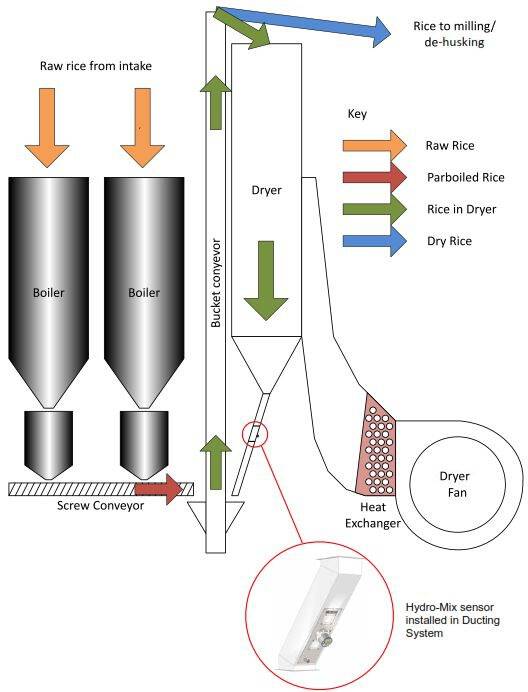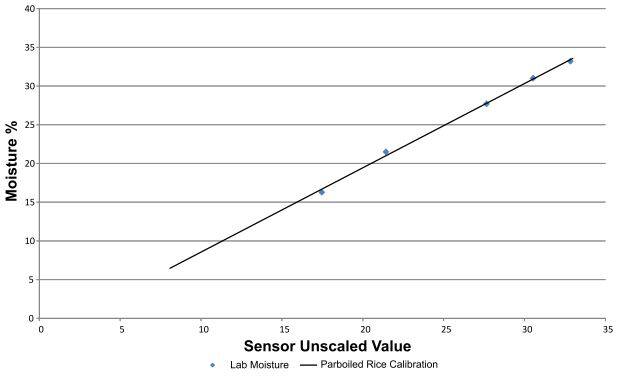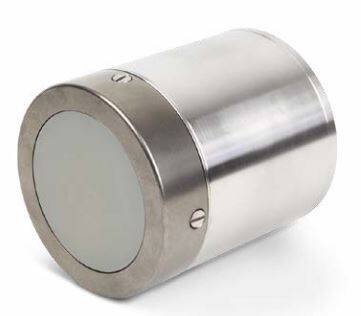Around 50% of the worlds’ paddy rice production is parboiled. This is a process during rice production in which the paddy (raw) rice is steamed in the husk and then dried. This hardens the individual grains making them easier to handle and reduces the amount of broken kernels during milling. Other benefits include an increased product storage life, an increased nutritional value and sterilisation of the grain.
The need to measure moisture
There are three basic steps to the parboiling process. While in the paddy form, the rice is soaked to achieve an optimum moisture level typically around 30%. The rice is then heat treated by steaming or boiling which gelatinizes the starch within the kernel. This part of the process increases the moisture content of the rice grains to around 38% Finally the rice is dried to a moisture level of 12-14% where it can then be stored or moved through to a milling process.
Incorrect moisture levels in the parboiled rice leads to breakages during the milling and de-husking process and colour variation in the final product after polishing. This results in wasted material which increases production costs. In addition, parboiled rice contains a higher percentage of moisture than field rice and therefore requires a greater amount of energy to dry it to the correct moisture level. Accurately controlling the drying process will reduce the amount of energy required and will also produce a high quality consistent product while also reducing costs.
The benefits of installing Hydronix microwave moisture measurement sensors:
- Dryers can be used more efficiently reducing energy costs
- Improved and consistent final product
- Reduction in the level of broken kernels and wasted material
- Not affected by dust or colour

Hydro-Mix moisture sensor installed in ducting after the dryer
Recommended Installation
In a typical process plant, after soaking, the rice is boiled or steamed at 90-100°C for a fixed time. The material is then emptied via a screw conveyor into a bucket conveyor which recirculates the grain through a drying tower where it has hot air blown through it. Depending on the plant, each dryer can hold 16,000kg of rice and the bucket conveyor recirculates through this continuously. Each recirculation loop takes approximately 1 hour. The drying process which takes between 8 to 10 hours dries the parboiled rice from around 30% moisture down to a target of 12-14%.
Installation is dependent on the individual plant setup however the sensor needs to be mounted so that there is a consistent amount of material flowing over the sensor’s measurement surface. A typical installation would mount the sensor where the rice exits the bottom of the drying tower and goes back into the hopper for the bucket.
Calibration
When measuring the moisture content of rice it is normal for the sensor to be configured to output a value that represents the percentage of moisture in the rice. In order to output a moisture percentage it is necessary to calibrate the sensor.
The sensor is calibrated after installation. The calibration process correlates a range of measurements taken by the sensor at various moisture levels to the actual moisture level of the material. This is derived by taking a sample and conducting a laboratory test.
As the material cycles through the dryer the moisture level is continually reducing. A sample of rice is taken each hour and the sensor’s raw value (Unscaled value) recorded. The actual moisture content is determined and the two values are input in to the Hydronix HydroCom calibration software. Once a suitable range of calibration points have been entered in to the software the sensor will continuously output an exact moisture percentage.
The Hydronix digital measurement technique ensures that the sensor is very stable and that the measurement is linear. This means that the calibration process only needs to be performed once during the sensor installation. Hydronix recommend that subsequent checks of the calibration are performed as part of a normal quality assurance program.

Figure 2: Parboiled Rice Calibration
Figure 2 shows a typical calibration line for the moisture content of parboiled rice which correlates the sensor’s raw value (Unscaled value) to the actual moisture percentage of the rice. Because the sensor has been designed to respond in a linear fashion to changes in the rice moisture content the sensor can precisely interpolate any Unscaled value and output the appropriate moisture percentage.
Cost Savings
The costs benefit of installing a Hydronix sensor falls into two main categories.
- Waste Reduction Savings: If for example a single dryer is processing 16,000kg of rice every 12 hours, and assuming 2 shifts per day and working 5 days per week, this equates to 160,000 kg of rice processed per week. The installation of a moisture sensor could reduce the amount of rice being wasted due to broken or spoiled grains by 2.5% which equates to 4,000 kg per week. The current market price of rice (as of June 2016) is US $417 per metric ton so reducing the broken rice could save up to US $1,668 in just one week, or assuming a working year of 48 weeks, a total saving of US $80,064.
- Energy Savings: A correctly installed sensor will measure the moisture levels of the materials exiting the drying tower to an accuracy of +/- 0.5% enabling the dryer to be controlled more precisely. Real time control of the dryer ensures that the dryer is controlled instantaneously resulting in increased energy efficiency.

Hydro-Mix moisture sensor
Hydronix moisture sensors
Hydronix moisture sensors are constructed to withstand the harshest of industrial environments. The sensors are immune from the effects of colour changes in the rice and dust or moisture in the atmosphere. They are designed to be fully temperature stable and are manufactured to exact tolerances ensuring that each sensor has identical measurement characteristics. This means that they are precise, easy to use and reliable.
In this application and installation, Hydronix would recommend the Hydro-Mix sensor which has been designed for flowing organic materials such as grains, nuts and pulses. The Hydro-Mix has configurable parameters such as signal filtering and smoothing designed to eliminate measurement noise created by small fluctuations in material flow density. The sensor also features configurable alarms and a material temperature output. The user may select from a choice of output options such as 0-20mA (0-10V), 4-20mA, USB, Ethernet and RS485/232 and may be configured to output a moisture percentage value directly from the sensor. The Hydronix Hydro-Com software enables simple set-up and configuration of the sensor using a PC or laptop and USB connection.
Conclusion
Hydronix is at the forefront of microwave moisture measurement research and development. Advances made by Hydronix over recent years have uniquely enabled Hydronix digital sensors to be used successfully in applications that were not previously possible. The digital measurement technique is now proven to give highly accurate and reliable results allowing rice processors the ability to more accurately control their process. A significant increase in profitability may be achieved through waste reduction, yield maximisation and the efficient use of energy. The sensors will normally return a payback on the investment in a matter of weeks after installation.


